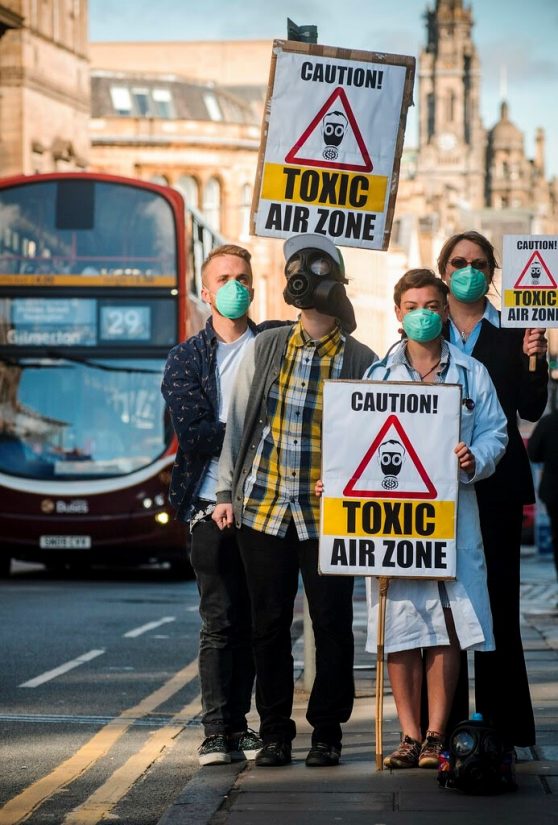Air pollution: Our lingering pandemic, but one we can control

While rising temperatures and increasing concentrations of greenhouse gasses tend to steal the thunder of atmospheric-related news, air pollution is another nefarious anthropogenic factor negatively affecting the human condition. The World Health Organization estimates air pollution kills 7 million people each year.
Long before “climate change” was a thing, images reflecting the world’s great “industrial revolution” are dominated by smoke billowing from factories and darkened daylight skies over industrial cities. As Charles Dickens wrote of London in 1852 in Bleak House, “smoke lowering down from chimney-pots, making a soft black drizzle, with flakes of soot in it as big as full-grown snowflakes.” While pandemics come and go, anthropogenic air pollution remains.
In the city of my youth, Pittsburgh, Pa., airborne soot from a thriving steel industry many decades ago so blackened the daytime skies that the gas-fueled “street lamps” had to be lit so people could safely navigate the city. Even today, long after the collapse of the steel industry there, Pittsburgh’s air is much clearer, but its air quality remains among the worst in the nation.
More widespread than the eye can see
And therein, is perhaps the crux of the problem. Even as the skies have cleared over some industrial cities around the world, a clear sky is not necessarily free of pollutants. And some of the world’s largest cities don’t even have clear skies. Los Angeles, Delhi, and Beijing — to name a few — are notorious for persistent health-threatening smog. Prior to the COVID-19 medical emergency, it was common to see people in China wearing face masks as they navigated through their heavily polluted cities.

Now, with COVID-19, wearing a face mask has taken on a different kind of sad significance. And to make matters worse, prolonged exposure to air pollution is linked to an increase in COVID-19 death rates, according to research conducted in the U.S. by the Harvard T.H. Chan School of Public Health. In Louisiana’s St. John the Baptist parish, where a petrochemical plant is cited as a major source of air pollution, the risk of cancer is the highest in the U.S., and COVID-19 deaths are disproportionally high.
Less polluted air, for now, but health risks remain
Wherever you live, chances are your skies have been clearer in recent months — perhaps clearer than you’ve ever noticed. Just weeks into the international stay-at-home orders, people in notoriously polluted cities like Delhi, where air quality index levels typically rank off-the-chart unsafe, enjoyed smog-free skies. The Guardian published stunning before and after photos of Delhi’s clear skies, revealing distant landscape not visible through its pre COVID-19 haze.
Los Angeles, too, enjoyed a reprieve during stay-at-home restrictions. Its clearer skies resulted from the abrupt and dramatic reductions in vehicle traffic, which is California’s biggest source of air pollution. In fact, air pollution from vehicles plummeted around the world, albeit due to a tragic pandemic.

But as the global economy slowly rebounds from COVID-19, the scourge of air pollution again will be among us. Air pollution disproportionately hurts the poor, makes everyone more vulnerable to COVID-19 — regardless of economic status — and prematurely shortens millions of lives each year. As the world gradually attempts to return to whatever our new normal will be, government officials, too, will return to urgent matters of how to meet the increased energy needs of a planet of 7.8 billion and growing.
The war against the environment
In the U.S., officials have chosen an unfortunate course of action: broad deregulation. The Environmental Protection Agency (EPA) in March suspended enforcement of some environmental laws during COVID-19, with no end date set. A notable example is for the oil industry, allowing refineries to stop reporting or even to reduce carcinogenic benzene emissions. Additionally, 10 companies fined $56 million by the EPA for polluting air and water can delay their penalties, thanks to a reprieve from the current administration.
There was a time when high-level government officials cared about clean air. Congress passed the Clean Air Act in 1970, supported by the Republican administration of Richard Nixon. How times and politics have changed.
Beyond resumption, a new path forward
It’s difficult to concentrate on environmental matters or COIVD-19 or much else in a time when the U.S. is in the throes of protests against the pandemic of systemic police brutality and racism. The senseless death of George Floyd has resonated worldwide, and African-American leaders sense a true turning point — hoping, moving forward, that solidarity in support of Black Lives Matter will result in true police reform.
The same can be true for reforming industry and reducing health-threatening air pollution. Prior to COVID-19, momentum was building for some semblance of a global Green New Deal. For the first time, it’s cheaper to invest in renewable energy than soot-spewing coal plants or controversial biomass burning plants. And in the U.S., hydroelectric generators are among the oldest power plants, but can be replaced by solar power and improving energy storage technology to provide power at night.
For those of us privileged enough to have few worries in a troubled world, it took a pandemic to illuminate how we’ve long been suffering from the air pollution pandemic. It shouldn’t take much more to understand it’s yet another pandemic we can control, if we so choose.